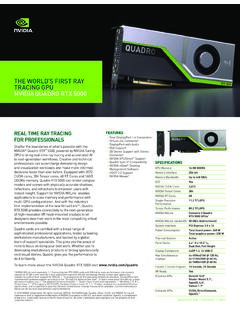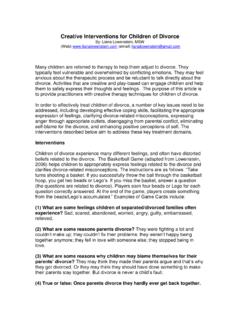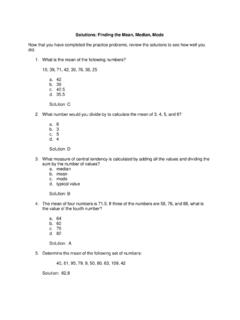Transcription of Cheat Sheet for Neurofeedback - StressTherapy Solutions
1 Cheat Sheet for Neurofeedback Steven Warner, Miami, Florida 01/2013 1 Cheat Sheet of the Brain Synthesis for Neurofeedback Table of Contents: Page 1 - Left and Right Hemispheres, Overview Page 1 - Prefrontal Cortex Page 4 - Frontal Lobes Page 5 - C3, Cz, C4 Somatosensory strip Page 6 - Temporal Lobes Page 7 - Parietal Lobes Page 7 - Occipital Lobes Page 8 - Special Functions: Page 8 Frontal lobes Page 9 Sensory Motor cortex, Temporal lobes Page 10 Parietal and Occipital lobes Page 11 Deeper Brain Structures Page 13 - Brain Wave Frequencies: Page 13 Gamma, Beta Page 16 Alpha Page 18 Theta Page 20 Delta Page 21 - Neurofeedback Concepts: Absolute Power (21), Relative Power (21), Mean Frequency (21), Asymmetry (22), Coherence (22), Phase (23), Normative Bandwidth Distributions (24) Page 25 - Drug Effects on the EEG Page 26 - Brodmann Areas 2 LEFT HEMISPHERE OF THE BRAIN RIGHT HEMISPHERE OF THE BRAIN Dominant hemisphere Analyzes reduces a complex concept or process into its individual components.
2 Detail oriented. Thinks sequentially one word after another, one note after another. Thinks linguistically perceives, comprehends, stores in memory, formulates and expresses. Thinks logically, good at math and analytical reasoning. Verbal memories. Men are stronger with spatial abilities using both sides of the brain; directions, maps or puzzles Beta tends to be higher Theta roughly equal left & right Synthesizes takes components and combines them into an integrated whole. Experiences the process in its entirety. Thinks spatially/holistically putting puzzles together, hearing the musical chord. Intuition and insight. Perceives, comprehends and expresses visual and auditory social cues reading faces, remembering places, creating facial expressions, comprehending and creating vocal intonation.
3 Creativity, empathy, early self-concept. Experience and express emotion anger, rage, anxiety. Mood regulation emotional contextual. Alpha tends to be higher Specificity to sites is slightly misleading these are best guesses and all functions are a result of the interaction of many areas. The typical site is differentially engaged in 40% of behavioral domains. Prefrontal Cortex Fp1, Fz, Fp2 Executive functioning establishes goals, inhibits information extraneous to the goal directed planning process, plan and make decisions, working memory. Prefrontal lobes have connections to the amygdala. Self-regulation, initiation, social-emotional behavior in 3 social context, recognition and production of expression of language (prosody) Decrease in left prefrontal activation may reflect depressive experience where increase in right prefrontal activation may reflect anxieties.
4 Prefrontal lobes have neuronal networks leading to the amygdala. Autonomic Nervous System regulation Attends to internal and external stimuli, Determines the amount of attention that will be distributed among competing stimuli. Supervisory Attentional System - Sustained attention. Motor Control and Programming Calls up memory and utilizes it Ability to inhibit behavior appropriately in complex social contexts Delayed gratification Mental flexibility Understanding the concept of past, present and future. Provide awareness of what is rewarding and pleasurable Regulation of emotions (modulate and inhibit impulses) Organising, creative , problem solving Ability to learn from experience. Reality testing Development of personality Attachment, conscience, empathy Fz frontal eye fields, motor, focus and action observation.
5 (Fpz emotional inhibition, modulation of emotional (sensitivity) and behavioral responses, motivation/attention.) Fp1 & F3 logical, detailed attention, the organization of responses (like a conductor), semantics Fp2 & F4 emotional/contextual attention 4 Fp1 - verbal retrieval. Visual working memory, verbal analytical and approach behaviors Fp2 - Face and object processing, gestalt and context, episodic memory ( when overactive may correlate with irritability, impulsivity, tactless, manic and panic behavior) Frontal Lobes Higher executive functions Attentional gating. Decision making. Problem solving, memory, social awareness, character, motivation, planning, judgment. Frontal lobes are responsible for immediate and sustained attention, social skills, emotions, empathy, time management, working memory, moral fiber or character, executive planning and initiative.
6 They identify problems and may send them to other parts of the brain for resolution. The brain is not just a cognitive processing organism; it is also the seat of our conscience. Emotions, morals and social self cannot be isolated to frontal lobe activities; other deeper structures are also involved. There is a relationship between the frontal lobe and the amygdala. The frontal cortex is responsible for the brains most complex processing and has the heaviest projections to the amygdala, and the two combine to form a network that is the social brain. F3 & F7 - Approach behavior, engagement, interest, mood regulation, processing of positive emotional input, conscious awareness. Frontal mirror neuron system empathy and intention of others. F3 judgment, planning, sustain attention, inhibition of responses, verbal episodic memory retrieval, problem solving, sequencing, deducing facts to conclusions.
7 F7 - Creates and controls output of spoken and written language, visual and auditory working memory, selective attention Broca s area (word retrieval, F4 & F8 - Avoidance behavior, withdrawal, impulse control (important links to the amygdala). Emotional tone variations (motor aprosodia) F4 inductive creative , inductive emotional, metaphorical thinking, short-term retrieval of spatial-object memory, vigilance, selective and sustained attention. F8 spatial and visual working memory, gestalt, sustained attention, conscious facial emotional processing, prosody Empathy conscience. Feeling sense of right and wrong. Emotional gating. Vigilance area. 5 semantics, verbal understanding, speech) Divided and selective attention Apprehension, disinterest Sustained and selective attention Processing of anger, rate, anxiety, fear.
8 Regulation of aggressive and sexual impulses C3, Cz, C4 Central Strip The sensory and motor cortices run parallel to each other and are divided by the central sulcus. The two cortices combined are called the sensorimotor cortex. The sensory cortex alone is the primary somatosensory cortex or the somatosensory cortex: spatial discrimination and the ability to identify where bodily functions originate. Responsible for both the external senses of touch, temperature, pain and the internal senses of of joint position, visceral state and pain. The primary motor cortex may be called just the motor cortex - conscious control of all skeletal muscle movements. Skillful movements and smooth repetitive operations such as typing, playing musical instruments, handwriting, the operation of complex machinery and fluid speaking.
9 It is the hub and switching station between voluntary muscles of the body and the brain. Cz somato-sensory association cortex (? Hub of affective limbic system). Sensory-motor functions, short term memory Awareness of body, body position, body movement, co-ordination of sensory input with motor output. Gross motor activity, walking, throwing a ball Fine motor movements pen skills, needle threading, typing, speaking. C3 hand and digits (with F3 handwriting and inhibit or execute action), audition, happiness, C4 cognition of music, reasoning/decision making and emotional/feeling, and in addition, disrupts the process of basic body 6 syntax signaling, happiness & sadness The Sensorimotor cortex not only divides the anterior from the posterior, but they also serve as a junction that coordinates movement that is also in part guided by sensations.
10 Temporal Lobes T3 & T4 Auditory Association cortex; phonetics, letters to sound, grasping the whole picture vs. sensing everything in fragments (may be dysfunctional in autism), episodic memory, emotional valence and regulation (temper). Without clear left hemisphere dominance, dyslexia and stuttering may occur. Because women have up to 30% more interhemispheric connections, they manage dyslexia better and understand interpersonal emotions better. T3, T5 (left) Wernicke s comprehension both verbal and reading visual perception of what an object is processing integration and perception of auditory input comprehension of auditory and visual perception (reading and word recognition) long term memory auditory (verbal) and visual linguistic perception and comprehension Inner voice positive mood T4, T6 (right) conscious emotional and physical awareness (insula), sense of direction visual memory & visualization, categorization sound voice intonation perception, music facial recognition spatial and facial perception - social cues T4-T6 Central Strip (Temporal-Parietal junction RHS copying emotional tones, comprehension innuendo & nuance, non-verbal memory visual perception of what an object is (object recognition))



